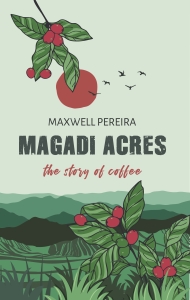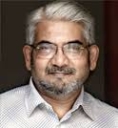
1. Onset of Magadi Acres
It was pitch dark when we alighted from the taxi. “We have reached the estate,” announced my father, Ligor, to me and my younger brother Munnu—his two eager beavers. Goveas-mam, the plantation Writer1, was there to receive us. A diminutive old man sporting stained white walrus moustaches under a tiny balding pate, he was clad only in khaki knickers and a white muslin jubba over his banian. He greeted us in the dull glow of a kerosene chimney.
I always remembered my debut into the wilds. I was then under ten, when Dad bought his first coffee estate in the Western Ghats. Coffee plants in neat rows and blocks, under a canopy of manicured trees that were wild and tall. Amidst surrounding virgin forests of thorny lantana encompassing the million plus shrubs and other growth below the giant trees and clusters of huge dry bamboo bushes. Wild areas that one did not venture into without help preceding, cutting a way through with long cutlasses and chopper knives ahead of you. How come there were no green bamboos, I had wondered.
Dad had bought Magadi Acres in the winter of 1953 and promptly dedicated it to Saint Anthony—a fact that my mother, Estelle, particularly made us children aware of while repeatedly asking us to pray for the success of Dad’s new venture. ‘Saint Anthony pray for us’ had since become a constant refrain. Dad had scraped together all his pennies to buy this first plantation in Sakleshpur. For some reason about which we boys only learnt later, he preferred to call this town Sakalaishwaryapura. At which stage in time, the only circumstance that stopped Mom from joining her husband on the estate was the impending marriage of Bulbul, our eldest sibling.
So, for my kid brother Munnu and me, our trip to the estate had to be only in the middle of 1954, when the summer vacation at our school, Saint Aloysius’, had followed. While returning from one of his imminent and frequent visits back home to Mangalore, where we lived, Dad made us accompany him to the plantation. For us it was an expedition into the unknown, with understandable trepidation.
We boarded the Krishna bus service from Hampankatta bus stand in Mangalore and travelled to Sakleshpur—the nearest town-head for the estate behind Halasulige village; a five-mile trek away. Dad’s Sakala-aishwarya-pura had by now evolved into Sakaleshapura—as the inhabitants called their little town in local Kannada—suitably anglicized and adopted by the colonial masters into Sakleshpur. It was common for towns in India to have an anglicized version of their native names suitable to the likes and sounds of the colonial masters, not necessarily always sounding the same.
The period was before India re-organized its States in 1956 post its Independence in 1947. So, there was a change of buses at Shiradi-ghat, the inter-state border. The village of Shiradi was on the border between South Kanara District in the then Presidency of Madras, and the Manjarabad Taluk in Malnad of the then princely State of Mysore. The Central Act of 1956—considered a major reform in the boundaries of the nascent Indian Union of States and Principalities—reorganized the new independent India mainly and ostensibly on linguistic basis into 14 States and six Union Territories—removing and changing long existing borders and creating new ones. This brought anguish and disharmony for many, and doubtful relief to some others.
Our family was in Mangalore then, and the graver implications of this reorganization were lost on us. We had other concerns that impacted the family more, that being the landmark year when Bulbul got married, and more importantly, it was also the year when we were sent to boarding school. That is when our parents wound up Sukh Sagar, our family home in Mangalore and moved lock, stock and barrel to Magadi Acres in Sakleshpur.
And, in those days, we children could only be seen and not heard. So, there were restrictions and limitations on what we ventured to ask and get answers to. But youthful curiosity always got the better of us. There were agitations in Mangalore as well—when Kasaragod, a neighbouring Taluk to our town in South Kanara district, we learnt, was arbitrarily merged with the newly formed tiny State of Kerala; thereby ostensibly consolidating the meagre holdings of the erstwhile princely states of Travancore- Cochin with the Malabar district, and Kasaragod Taluk of South Kanara of the Madras Presidency.
South Kanara even otherwise was impacted majorly by the reorganization, when the whole district along with its neighbouring district of Coorg, got merged with the princely holdings of the then existing Mysore Kingdom to form the new Mysore State.
The rickety bus ride was indeed an expedition. Unlike in later decades when the distance could be covered in under two hours, those were times when it took the bus a minimum of eight hours chug-chugging along. There were numerous halts in between to board and alight passengers from and at their destinations in between.
That is when we first encountered the suburbs along the bus-route, of Bantwal and then Panemangalore. For Bantwal the bus took a diversion at B.C. (Bantwal Cross) Road, to service likely passengers of this important suburb—which was also the headquarters of the neighbouring taluk. From Bantwal bus stand, the bus returned to the main route at BCR; and within a short while stumbled upon the stretch of a beautiful avenue with shade-providing trees on either side that connected the bridge to Panemangalore. Not before though we passed beside the Narahari-betta soon after BCR where my class had picnic-ed not too long ago, and not before we crossed a rather longish bridge, the largest perhaps we had ever seen in our tender years. Later we learnt that the river under this bridge was none other than the Netravati that ultimately joined the Arabian Sea at Ullal—another suburb of Mangalore to its south—made famous by its erstwhile queen, Rani Abbakka, for valiantly defeating the Portuguese. The Netravati beside Panemangalur triggered another memory; not necessarily a happy one, at least for me.
I remembered falling into the frothing, flooded river and being saved by the Bearys4 just over a year ago. I could not help narrating the story to Munnu sitting beside me in the bus. Our little sister Babita was just a babe then in Mother’s arms, and I was eight years older, and not yet nine. The child took ill one day, and the local quack’s penicillin-based treatment resulted in an allergic reaction. She would never recover and often burst into large boils of all hues and colours over her tiny frame, which was heart-rending and nothing on earth seemed to cure.
Those were days with little confidence in modern-day allopathy, but full of wonderful grandma’s remedies for all occasions and ailments. And that’s how granny decreed that the blood of bats and tortoises be procured to massage the little one.
About the Author




Comments